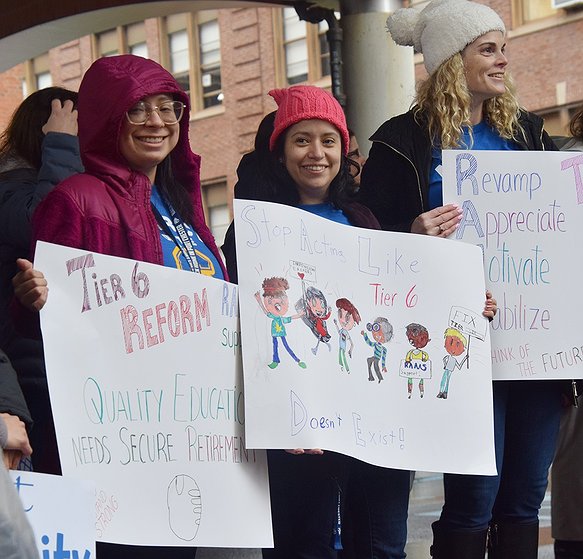Civil servants stand together at PCHS to call for changes to tiered pension plan
March 14, 2024 at 2:31 a.m.
Tucked away in a backroom near the Port Chester High School auditorium, Chris Kazim walked through his office, pointing out the newly added decorations adorning the walls.
“These are the signs that survived,” the Port Chester Teachers Association (PCTA) president said. “I wanted to keep them all, but only the laminated ones made it.”
“Support our Educators,” “Keep our schools strong” “Fix Tier 6” read a few of the posters lining the walls. In the center, a blue T-shirt, covered in signatures, was displayed. “I couldn’t get everyone who was there, or it would have just turned into a black shirt,” Kazim laughed.
The memorabilia serve as a reminder of the “March on the 6th to Fix Tier 6” rally that occurred just outside the building on Wednesday, Mar. 6. Kazim had been planning the event for several months.
“During a union gathering, I was approached by several new teachers who were concerned about Tier 6,” he recalled. “Most people, when they’re 24, aren’t thinking about retirement, but this new generation is.”
Their questions about what could be done for them stuck with the PCTA president. So, he took action.
How do the tiers work?
Both the New York State Employees Retirement System and the Teachers Retirement System operate on a tiered pension plan. Each tier added since their initiation in 1973 has seen alterations, ranging from employee contributions to the minimum age of retirement before penalties are incurred.
Teachers hired within the time each one was introduced by the New York State government falls into their perspective category. For example, a teacher hired between 1983 and 2009 fell into Tier 4, while educators hired between 2010 and 2012 are Tier 5 employees. Anyone hired after 2012 is in Tier 6.
When the State Assembly passed Tier 6 in 2012, former Governor Andrew Cuomo championed the program as one that would save the government money. In a statement his office put out after the designation was passed, he wrote: “In 2002 pension payments from local governments were $1.4 billion and have grown to $12.2 billion in 2012.”
It was a move that was, and has continued to be, widely criticized by union leaders.
“The short of it is that Tier 6 employees have to work longer,” Kazim explained. In order to receive their full pension, educators have to work until they’re 63, eight years more than their Tier 4 colleagues.
“For someone that’s 23, right out of graduate school, that’s 40 years of service,” he said. “If they retire earlier, they get hit with penalties.” Educators see a 6.5% reduction in their pension should they choose to leave the profession before turning 63. “That means if they retire at 55, like Tier 4 members, they see a 52% reduction in their pension.”
Additionally, Tier 6 members have to continuously contribute 3% to 6% of their salaries into their pensions, based on their income.
It’s an issue that hit home for Kazim, as someone who benefitted from others advocating for change.
In 2000, 17 years after Tier 4 began, New York State United Teachers (NYSUT), the statewide teachers’ union, lobbied to have retirement contributions capped at 10 years, ending career long payments of 3%. Kazim, who began his career in the Port Chester School District as a teaching assistant 17 years ago, wants to do the same for those who have entered the workforce after him.
No march, no problem
“I was driving home and the phrase ‘March on the 6th to Fix Tier 6’ popped into my head,” Kazim recalled of the crafting of the catchy name. From that point, he spent the next several months planning the event, aiming to draw attention to the disparities seen in Tier 6.
He announced the rally publicly at the Port Chester Board of Education meeting in January, expressing the hope that others, including district administrators and board members, would attend in solidarity with the cause. He also reached out to other labor unions, such as the CSEA and other teachers’ associations across the state, to join.
Originally, the march was slated to take place at Port Chester Middle School, with attendees walking up Bowman Avenue to Ridge Street, taking a left toward Westchester Avenue before looping back to the school.
Unfortunately, Mother Nature decided to rain on their parade.
A steady downpour throughout the day forced a venue change—a move to the high school, under the shelter of the parking lot along Tamarack Road. Instead of marching around the neighborhood, attendees marched from the rear of the building to the front by navigating through the entrance, ending at the flagpole. Kazim was afraid the 40-degree weather and wet conditions would lower attendance.
But the public servants of New York showed no fear of water.
“I was surprised,” Kazim said. “But I was very happy with the amount of people who came out to support us.” Around 300 people braved the rain in a show of solidarity, donning ponchos while looking to show they were standing up for the Tier 6 workers.
“There were people from 15 different teachers’ unions, from Harrison to New York City,” he recalled. NYSUT President Melinda Person and President of both Westchester County Local 860 and Unit 9200 Hattie Adams spoke on the importance of adjusting the pension plan to provide dignity in retirement for civil servants.
“The pension system is meant to serve as a recruitment and retention tool,” Adams, a Port Chester resident, said at the event. “However, since the creation of Tier 6, it no longer does.”
The impact of Tier 6
Adams, along with Kazim, see fixing Tier 6 as part of the solution to the New York employment shortage.
Currently, there are 11,000 vacancies in the state workforce and it is estimated that it needs 180,000 teachers in the next 10 years to meet the requirements of the New York State education system.
Some faculty in the Port Chester School District have felt the staff shortage in the buildings. Jennifer Acuña, who has served as a teaching assistant, explained she would be used as a substitute for long periods of time. “Sometimes my subbing would be for four days, but once it was for three weeks,” she explained. “And it was difficult because I’m not a teacher by training. I could only do so much for the kids.”
“Because there’s a staff shortage, there isn’t a lot of time to provide the services that we want to provide students,” psychologist at John F. Kennedy Elementary School and Tier 6 employee Randy Moran elaborated.
Kazim credited Tier 6 as being partly responsible for the educator shortage found across the state.
“The shortage and attrition of teachers in New York has been an issue for 10 years,” he said. “There are a lot of factors, like COVID, the Baby Boomer generation retiring and just lower enrollments in teacher prep programs, but this compounds it.”
The PCTA president would like to continue to advocate for change in the pension system. “For the sake of the communities we all serve, not just the educators. Public service jobs matter,” Kazim said. “I’m going to keep advocating for this because it’s an issue that should matter to everyone. I’m hoping changes happen and the shortages disappear.”
Though he’s hopeful for change, he understands it’s an endeavor that will take time. “It took 17 years to fix Tier 4,” he said. “But at the end of the day, this movement will impact our classrooms, our students and our community as a whole. It will take a village.”
Looking back on the event, Kazim believes it couldn’t have gone better. “The feedback I’ve gotten has all been positive,” he said. “It was a great event for public servants, you could see how this isn’t just a Port Chester issue, but we all came together here for the same cause.”
However, there is one thing he would change. “Next time, if there’s inclement weather, I’m bringing plastic sheets for my speech,” he laughed.






Comments:
You must login to comment.